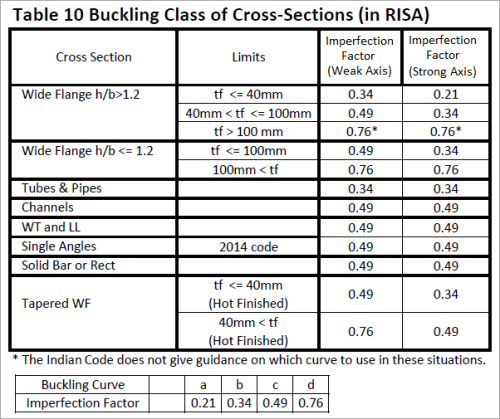Indian Design Parameters
Parameters controlling the steel design are entered on the Member Design Parameters spreadsheet. These parameters are entered on a per member basis, and control the code checking on a per member basis.
Cm Interactive Bending Coefficients
If these entries are left blank, RISA will calculate them. The m value is influenced by the sway condition of the member and is dependent on the member's end moments, which will change from one Load Comb to the next. It's a good idea to leave these entries blank and let RISA calculate them.
Indian Buckling Curve Factors
This factor is discussed in Section 7.1.2.2 of the 2007 Indian Design code and is used in the calculation of the axial compression. The following illustrates what RISA uses for the buckling curve from Table 7:
Click on image to enlarge it
Indian Limitations
Tapered Members - Tapered WF shapes are done per the AISC ASD 9th (for the 1998 code) and LRFD 2nd (for the 2007 code) specifications at this time. The appropriate sections of the IS:800 specification will be used in a later release.
Torsional Warping Effects- Combined bending and warping torsional stresses in WF and Channel shapes are handled per the AISC publication "Torsional Analysis of Steel Members".
WT and Double Angle Limitations - The Indian code does not address the case where Lateral Torsional (or Flexural Torsional) Buckling occurs for WT's and double angles bent about their weak axis. For the 2007 code, RISA will use the AISC 360-05 (aka AISC 13th edition) formulas for calculating member capacity for these failure states.
Shear Stress - For all shapes, the average shear stress is not checked per section 6.4.2 at this time.
Class 4 (Slender) Sections - No code checking is performed for class 4 sections for the IS 800: 2007 code.
Single Angles - Single angles are checked for axial and shear forces only. No bending is considered at this time.
